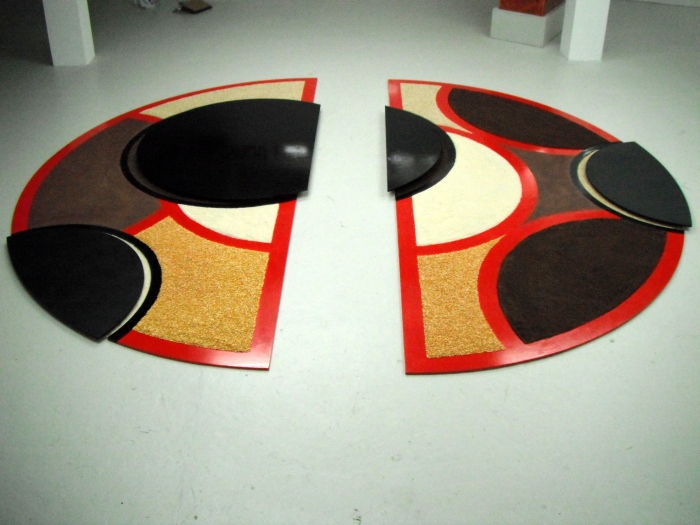Way back when I posted the design for this piece I mentioned that I would post a full analysis once it was finished. It’s been a while, but it’s better late than never!
The piece has been designed to encourage the audience to experience the work in more than one way, not just looking. The space in between the two semi circles enables the viewer to walk through the work, not just around it. Specific sections are slightly raised from the floor and have hidden material underneath them, the viewer can bend down and get closer to the work and discover all its different elements. The materials have been carefully selected to pose a question to the audience; what it is? Some materials are more obvious than others, the viewer can use sight and smell to determine what they are. There is a variety of paints used and the finish of them is important; there is a mixture of high gloss and matt paint as well as sections which are wood stained to highlight the use of wood. The distinct difference in the finishes of the paints create a contrast between the different sections of the work, the gloss paint engages the audience with their own reflections and the reflections of their surroundings making them more aware of the space they are in at the same time as being immersed into the work.
There are two key contexts to the work; one is more conceptual concerning rules, methods and design decisions and the other addresses social and cultural issues such as the trade of substances through different countries, rules and orders within society. The idea of borders and boundaries connect the two contexts creating a diversity of ways for the audience to approach and interpret the work.
Each loose material is surrounded by a red ring symbolising an order or border, this could also be viewed as a protective barrier because the material is fragile or as a way of dividing up certain sections creating categories within the work. Each of these interpretations can be associated with the global reference of country borders. Today’s society is governed by rules which help retain social harmony, for example; the high way code, social and political correctness regarding race, gender and age. Each country has a border and in turn has rules unique in its government, people and culture. Country borders divide the earth up into 196 countries; each has its own name and is grouped in a collection of other countries, a continent. The materials I have used are heavily traded foods between different countries, the red lines around each substance divides it into its own category which reflects borders and boundaries of modern earth’s landscape.
The rules and decisions I have created to make the work are driven by my knowledge of borders; however there is a notion of play involved. You wouldn’t commonly associate play with rules and instruction because play is supposed to be free and impulsive, however the playful element in my work is converted into a game, a game with rules. As an artist I set myself certain rules, guidelines and theories in regards to the way the work is designed and made. Creating these rules for making is a reflection on my practice as a whole, the way I think and the way I make artwork. But it is also a reference to the other linking context about the rules that surround us. Making an artwork created using rules makes something that is aesthetically structured. I believe that all audiences can relate to some kind of structure and order, therefore there is a familiar aspect in the work for each viewer. This familiarity encourages the audience to unpick the work and make their own decisions about rules and structure.
